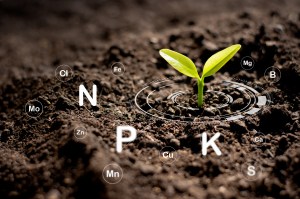Soil might be being discussed left, right and centre but, rather like an iceberg, there’s so much more going on under the surface that is yet to be unearthed and understood. CPM attended AHDB’s Agronomists’ Conference back in December to learn more.
“You can have all the nutrition in the world in your soil but if it’s not extractable, the plants will struggle.”
By Melanie Jenkins
Soil is not just a one-dimensional entity, but a plethora of interacting parts and organisms that function under the trio of chemistry, physics and biology working in unison, according to Ian Robertson of Sustainable Soil Management.

The worst thing is to have bare soil because it will stop capturing sunlight, says Ian Robertson.
“When we join soils and plants together, we’re really looking to try and understand some key measures in the soil and what the plants acquire from it.”
The first part of this is knowing what nutrients are in the soil, he says. “There are lots of ways of measuring this and we have to think about how the soil is reacting with plants. So just because there’s lots of nutrition in the soil, this doesn’t mean plants can access it.
“Once you know what nutrition is in the soil, think about what plants actually require,” explains Ian. “And remember there’s something called ‘peak demand’, where a crop requires a lot more of certain nutrients to grow leaf four, five, stems and tillers etc, and to hold the grain and take it through to harvest.”
But plants still must have the capability to access the nutrients in the soil. “AHDB has done a lot of work on root mass architecture and I think plant breeders are looking at this as well. The roots are the hands of the plants: the bigger their hands, the more food they can shovel in. This is what we want plants to do in the early growth stages.
“If they put a big root system down, they can intake nutrition to create the architecture to translate into yield. And don’t underestimate what a good root system can do for your soils.”
The next thing to consider is measurements – so how functional soils are. “We’re all talking about the health of soil but I think we should really be talking about functionality. It’s this that allows the extraction of nutrients by the crop. You can have all the nutrition in the world in your soil but if it’s not extractable, the plants will struggle.”
According to Ian, water plays a big part in the functionality. “Water is really important. Along with nutrient cycling and biology, they’re all playing a massive part in how functional soils are.”
Looking closer at soils, Ian delves into the intricate and complex world above and below the surface.
“The three aspects of soil: the physical, chemical and biological are interactive. If we affect the physics, that affects the chemistry and the biology. I believe we’ve over-focused on the physics and chemistry, because they’re easy. The difficult part is knowing how that affects the biology and it changes all the time.”
However, if the physics and chemistry are right, a lot of the biological aspects in the soil will rectify themselves, he adds.
“Key aspects of physics are soil texture and structure – you can have all the nutrients in the world but if the soil structure is poor, then the plants can’t access them.
“The colour of the soil can also be indicative of organic matter and how the layers of the profile merge into one another. We’re ideally looking for a soil where there’s no distinct lines as this means there’s connectivity between the topsoil and subsoil. Dig a hole to see what’s going on and note the smell – it’s a really good indicator.”
Then there’s stone content to consider, he says. “If you think that all of your soil is actually soil, it’s not – up to 20% of it can be stone – and this can have a massive impact on how much nutrition is in the soil.”
Bulk density is also a feature. “How heavy is your soil? If it’s really heavy, then there’s a high mineral content which can cause problems with soil structure and root accessibility. So measuring these elements allows us to understand where and how soil should perform, taking the guesswork out of the physics.”
This leads to porosity, he says. “Water is so important. The majority of nutrient uptake is through water. No water means little nutrient uptake and very poor microbial activity and supply alters with different soil types.”

Knowing what the cation holding capacity of soil is helps growers understand how it should be fed nutrition.
Cation exchange capacity – the ability for soil type to hold nutrients – is another vital element. “Sandy soils have very little CEC, whereas clays have a lot. Understanding what the cation holding capacity is helps you understand how the soil should be fed nutrition. Don’t go feeding low cation soils a lot of nutrition as these can’t hold onto it.
“But having a large holding capacity doesn’t mean it’s balanced,” he points out. “We’re then looking at what’s in the soil – such as, calcium, magnesium, potassium, phosphate, aluminium, ammonium – hydrogen – as this will affect the pH and in turn impact on how nutrients cycle and root accessibility.
“One of the essential aspects of soil chemistry is the pH and this affects the availability of cations held in the soil, he says. “The pH is a logarithm of the amount of hydrogen ions on the humus and clay colloids, and these can be replaced by any of the cations (the ums). Ammonium will be held on these colloids as well.
“Then also consider measuring what readily available nutrients are in the soil. This should be measured in kg/ha rather than in mg/litre so that we can join this up with what a crop requires.”
But it’s the biology which is the really exciting aspect for Ian. “However, it’s really dynamic and changes. We tend to look at things like trophic levels and how imbalanced these are. We’re looking at what the food source is and if it’s enough to support the different layers. The easiest way to check on the state of the biology is to go out and count worms – which is brilliant.” But Ian warns that a lot of people try to count worms when it’s too dry.
And then there’s organic matter, says Ian. “I love organic matter. It’s living and breathing, and good soil microbial activity breaks down organic matter, releasing carbon dioxide – that’s what it’s meant to do.
“The worst thing we can have is bare soil because then there is nothing to capture sunlight. And at that point, the soil is still breaking down organic matter and releasing carbon dioxide into the atmosphere but without a plant to capture it.”
Working tirelessly behind all of this are microbes, he adds. “The microbes in the soil work in synergy with the plants to feed them, but they will only work if soil has the right structure – which should be 45% minerals, 25% air, 25% water and 5% organic matter.
“If the structure isn’t right, there’s no point pushing big machines through. Structure starts at 0.003mm – finer than your hair – where the bacteria, fungi and nematodes live on the water film around soil particles. These microorganisms require food and this comes from the organic matter and root exudates from the crop plants you’re putting in the soil,” says Ian.
“Ultimately, we should be measuring all of this and thinking holistically. Tools like terra mapping, plant and grain analysis, tissue tests, SAP testing and above ground biomass can all create a picture and help you to develop a plan to nurture functional soils better.”
This article was taken from the latest issue of CPM. For more articles like this, subscribe here.




